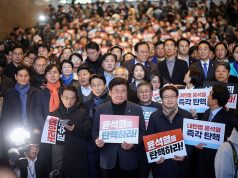
SEOUL/MOSCOW — North Korea’s latest missile test puts Washington within range, but Pyongyang still needs to prove it has mastered critical missile technology, such as re-entry, terminal stage guidance and warhead activation, South Korea said on Friday.
South Korea’s Ministry of Defense said the Hwasong-15 missile tested on Wednesday was a new type of intercontinental ballistic missile and can fly over 13,000 kilometers (8,080 miles), placing Washington within target range.
The test prompted a warning from the United States that North Korea’s leadership would be “utterly destroyed” if war were to break out, a statement that drew sharp criticism from Russia.
On Friday, Russian Foreign Minister Sergei Lavrov termed the threat from U.S. Ambassador to the United Nations Nikki Haley “a bloodthirsty tirade” and said military action against Pyongyang would be a big mistake, Russian news agencies reported.
“We will do everything to ensure that (the use of force) doesn’t happen so that the problem is decided only using peaceful and political-diplomatic means,” Lavrov said.
Separately, Russian lawmakers just back from a visit to Pyongyang said North Korea was not prepared to disarm, and while it did not want nuclear war it was morally ready for it, Russia’s RIA news agency reported.
Pyongyang has said its Wednesday missile test was a “breakthrough” and leader Kim Jong Un said the country had “finally realized the great historic cause of completing the state nuclear force.”
After North Korea released video footage and photographs of Hwasong-15, U.S. based experts said it appeared North Korea was indeed capable of delivering a nuclear weapon anywhere in the United States and could only be two or three tests away from being combat ready.
Yeo Suk-joo, South Korea’s deputy minister of defense policy, told the South Korean parliament that North Korea still needed to prove some technologies, like re-entry, terminal stage guidance and warhead activation.
Even so, South Korea’s Unification Ministry said North Korea was likely to pause its missile tests for a number of reasons, including the northern hemisphere winter season.
“For now if there are no sudden changes in situation or external factors, we feel there is a high chance North Korea will refrain from engaging in provocations for a while,” said Lee Yoo-jin, the ministry’s deputy spokeswoman.
North Korea is known to test fewer missiles in the fourth quarter of the year as troops are called to help with harvests, while the cold temperatures are a strain on the country’s fuel supplies.
This week’s missile launch was the first in 75 days.
South Korea Defense Minister Song Young-moo told parliament he expected North Korean leader Kim Jong Un to use his New Year’s Address to declare that North Korea had completed its weapons program.
South Korean and U.S. officials say the Hwasong 15 is the most advanced missile North Korea has ever tested.
Yeo told lawmakers the first stage engine of the missile featured a clustering of two engines from a smaller Hwasong-14 ICBM test-launched in July.
He said the Hwasong-15 is two meters (six feet) longer than the Hwasong-14. He said the second-stage engine requires further analysis.
Yeo said U.S. strategic assets would continue to be rotated on and near the Korean peninsula until the Pyeongchang Winter Olympics in South Korea next February in a bid to deter further North Korean “provocations.”
U.S. President Donald Trump has responded to the latest North Korean test with a fresh round of insults directed against Kim Jong Un, who he called “Little Rocket Man” and a “sick puppy.”
Trump has vowed to respond with tougher sanctions, but his administration has warned that all options are on the table in dealing with North Korea, including military ones.
North Korea has stuck to its effort to develop a nuclear-tipped missile capable of hitting the United States in spite of years of international sanctions and condemnation.









